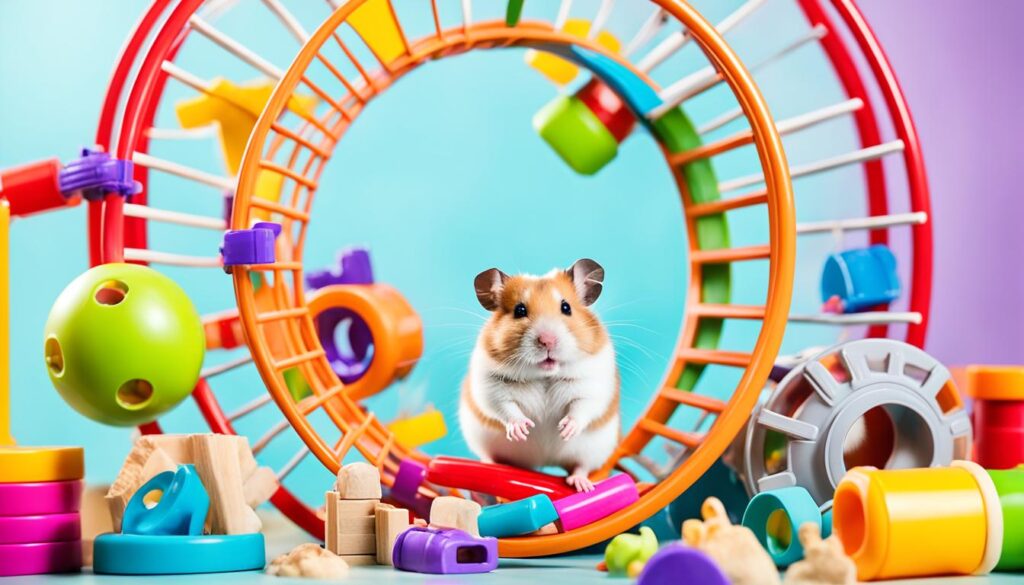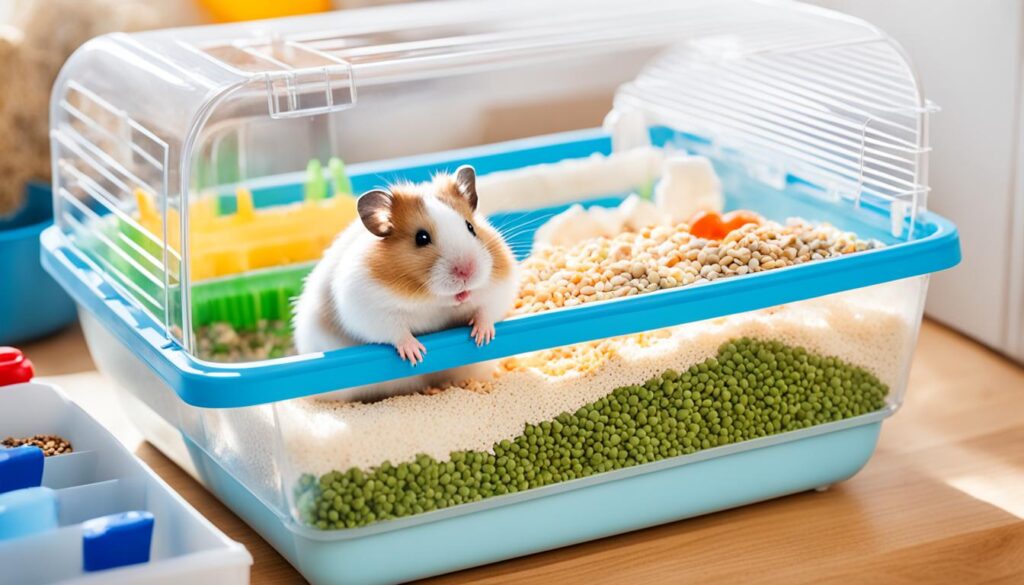Did you know that pet hamsters have a relatively short lifespan of just 2-3 years? Despite their small size, these adorable critters require proper care and attention to thrive. Whether you’re a first-time hamster owner or looking to improve your knowledge, this beginner’s guide will provide you with essential information on hamster care.
Key Takeaways:
- Hamsters have a lifespan of 2-3 years, so it’s important to make the most of the time you have with them.
- There are different breeds of hamsters to choose from, such as Syrian hamsters, each with its own unique characteristics.
- Understanding hamster behavior is crucial for creating a suitable environment and interacting with your furry friend.
- Providing a balanced diet, a comfortable habitat, regular grooming, and veterinary care are essential for a hamster’s well-being.
- Responsible ownership includes teaching children about the responsibilities of caring for a pet hamster.
Understanding Hamster Diet and Nutrition
Proper nutrition is essential for maintaining the health and well-being of your pet hamster. Understanding their dietary needs will help you provide them with a balanced and nutritious diet.
In the wild, hamsters have a diverse diet that includes plants, seeds, fruit, and insects. As pets, they require a diet that closely mimics their natural food sources.
Pelleted rodent ration: One of the main components of a hamster’s diet is pelleted rodent ration. This specially formulated food provides a complete and balanced nutritional profile for your pet. Look for a high-quality brand that contains 15-20% protein to meet their dietary requirements.
Fresh fruits and vegetables: In addition to the pelleted rodent ration, fresh fruits and vegetables should be included in your hamster’s diet. These provide important vitamins, minerals, and fiber. Some recommended options include carrots, broccoli, apples, and cucumbers. However, certain foods like onions, garlic, and lettuce should be avoided as they can be harmful to hamsters.
Recommended treats: As occasional treats, you can offer your hamster sugarless breakfast cereals and small amounts of cheese. These can add variety to their diet and serve as enrichment. Remember, treats should only be given in moderation to prevent weight gain and maintain a healthy diet.
Water: Fresh, clean water should always be available for your hamster. Use a water bottle or a shallow dish that they can easily access.
It’s important to note that every hamster is unique, and their dietary requirements may vary. Monitor their weight, overall health, and consult with a veterinarian if you have any concerns about their diet or nutrition.
Dietary Dos and Don’ts
- Do provide pelleted rodent ration with 15-20% protein
- Do offer fresh fruits and vegetables (carrots, broccoli, apples, cucumbers)
- Do give occasional treats like sugarless breakfast cereals and small amounts of cheese
- Do ensure fresh, clean water is always available
- Don’t feed onions, garlic, and lettuce
- Don’t offer sugary or fatty treats in excess
- Don’t forget to monitor your hamster’s weight and overall health
Providing a well-balanced diet is crucial for your hamster’s overall health and longevity. By understanding their nutritional needs and following these guidelines, you can help ensure a healthy and happy life for your furry friend.
| Food | Nutritional Value | Serving Size |
|---|---|---|
| Pelleted rodent ration | Provides essential proteins and nutrients | Adequate amount to meet daily requirements |
| Fresh fruits and vegetables |
Source of vitamins, minerals, and fiber | Small pieces, 1-2 times per week |
| Sugarless breakfast cereals | Additional flavor and texture | Small pieces, occasional treat |
| Cheese | Provides calcium and protein | Small amount, once in a while |
Creating the Perfect Hamster Habitat
When setting up a hamster cage, it is essential to create a habitat that meets their needs for comfort, stimulation, and safety. The right cage setup, bedding, ventilation, and accessories are key elements in providing a perfect environment for your furry friend.
Hamster Cage Setup
It is crucial to choose a well-ventilated cage for your hamster, as proper airflow is necessary for their overall health. Opt for cages made of wire, stainless steel, durable plastic, or glass materials. These materials not only provide good ventilation but also prevent your hamster from escaping.
Hamster Bedding
Deep bedding is essential for a hamster’s natural burrowing instincts. Provide a comfortable and safe bedding material for your hamster to dig, nest, and explore. Shredded paper, tissue, or wood shavings are popular choices for hamster bedding. These materials are soft, absorbent, and non-toxic.
Cage Ventilation
Proper cage ventilation is crucial to maintain a healthy and odor-free environment for your hamster. Ensure that the cage has enough openings to allow fresh air to circulate. Avoid placing the cage near direct sunlight or drafts, as extreme temperatures can be harmful to hamsters.
Hamster Cage Accessories
Enrich your hamster’s environment with a variety of accessories to keep them mentally stimulated and physically active. Exercise wheels, tunnels, hideouts, and chew toys are essential for their physical and mental well-being. These accessories provide opportunities for exploration, exercise, and play.
| Must-Have Accessories | Description |
|---|---|
| Exercise wheels | Help hamsters burn off excess energy and exercise their muscles. |
| Tunnels | Provide a fun and stimulating environment for your hamster to explore and hide. |
| Hideouts | Give hamsters a cozy space to rest and feel secure. |
| Chew toys | Help keep your hamster’s teeth healthy and satisfy their natural gnawing instincts. |
By incorporating these essential accessories into your hamster’s cage, you can create a stimulating and engaging habitat that promotes their physical and mental well-being.
Ensuring Proper Hamster Care and Grooming
Grooming plays a crucial role in keeping your hamster healthy and happy. While hamsters don’t require regular baths like other pets, they do enjoy sand baths to keep their fur clean and free from oils. However, there are other grooming practices you should incorporate into your hamster care routine.
Coat Brushing
Regularly brushing your hamster’s coat helps to remove loose fur, preventing it from matting or causing discomfort. It also promotes healthy fur growth and maintains a sleek and clean appearance. Use a soft-bristle brush or a specially designed small animal grooming brush to gently brush your hamster’s fur in the direction of its growth. Be sure to be gentle and avoid pulling on any tangles or mats to prevent hurting your furry friend.
Nail Trimming
Hamsters’ nails can grow long and sharp, which can be uncomfortable for them and potentially cause injuries. Regular nail trimming is essential to ensure their paws stay healthy. To trim your hamster’s nails, use a small pair of pet nail clippers or human nail clippers with a straight edge. Be cautious not to trim too much, as cutting into the quick can cause bleeding and pain. If you’re unsure about nail trimming, consult a veterinarian or a professional groomer for guidance.
Cage Cleaning
Maintaining a clean and hygienic living environment is crucial for your hamster’s health. Regularly cleaning the cage and accessories prevents the buildup of bacteria and keeps your hamster comfortable. Use a mild soap or a pet-safe disinfectant and warm water to clean the cage, toys, and any other items. Be sure to rinse thoroughly to remove any soap residue. Additionally, it’s important to remember to change the bedding weekly to maintain cleanliness.
Summary
- Hamsters don’t require regular baths but enjoy sand baths.
- Brush your hamster’s coat regularly to remove loose fur and keep it clean.
- Trim your hamster’s nails to prevent discomfort and potential injuries.
- Clean the cage and accessories regularly using mild soap and water.
- Change bedding weekly to maintain cleanliness in the cage.
Understanding Hamster Handling and Behavior
When it comes to handling your hamster, it’s important to approach them with care and respect. Proper handling techniques and socialization can help make your hamster docile and friendly. Let’s take a closer look at hamster handling and behavior to ensure a positive and enjoyable experience with your furry friend.
How to Pick Up a Hamster
When picking up your hamster, it’s crucial to be gentle and avoid any sudden movements that may startle them. The best method is to cup them in one or both hands, ensuring a secure and comfortable grip. By holding them close to your body, you provide a sense of security for your hamster.
Note: Never try to grab or lift your hamster by their tail, as this can cause harm and distress.
Taming Your Hamster
Taming your hamster involves gradually building trust and a bond with them. Begin by allowing your hamster to adjust to their new environment for a few days before attempting any interactions. Start by offering treats from your hand to establish positive associations. Slowly progress to gently petting them on their back or head.
Remember: Each hamster has their own personality, so be patient and understanding if your hamster takes more time to warm up to you.
Understanding Hamster Behavior
Hamsters are naturally curious and active creatures, so it’s important to provide them with a stimulating environment. They love to explore, burrow, and run on an exercise wheel. By offering a variety of toys, tunnels, and hideouts, you can keep your hamster mentally and physically engaged.
It’s also crucial to recognize that hamsters may exhibit defensive behaviors, such as biting, if they feel threatened or scared. Avoid sudden movements or loud noises that might startle them, and always approach them calmly and gently.
Tip: Regular handling and taming can help reduce any fear or aggression your hamster may display.
Common Hamster Behaviors and Their Meanings
| Behavior | Meaning |
|---|---|
| Fast, continuous running on exercise wheel | Physical exercise and mental stimulation |
| Burrowing and digging in bedding | Creating a safe and secure den |
| Stuffing cheeks with food or nesting material | Gathering supplies for nest-building or food storage |
| Chewing on cage bars or items | Wear down teeth and relieve stress or boredom |
| Biting or nipping | Feeling threatened or frightened |
By understanding hamster handling and behavior, you can create a positive and enriching experience for both you and your pet. Remember to be patient, gentle, and consistent in your interactions. With time and proper care, your hamster will become more comfortable and trusting, forming a special bond with you.
Common Health Issues and Veterinary Care for Hamsters
Ensuring the health and well-being of your hamster is crucial for their overall happiness. Like any other living creature, hamsters can experience various health issues that require prompt attention and professional veterinary care. In this section, we will discuss some common hamster illnesses and the importance of annual vet visits.
Common Hamster Illnesses
Hamsters are susceptible to several health conditions that can affect their quality of life. Here are some common hamster illnesses:
- Dental Disease: Dental problems such as overgrown teeth or tooth loss can occur in hamsters. These issues can lead to difficulties in eating and result in weight loss and discomfort.
- Respiratory Issues: Hamsters can develop respiratory infections, which may cause symptoms like sneezing, coughing, wheezing, and difficulty breathing.
- Skin Wounds: Hamsters are prone to skin wounds, including cuts, scratches, and abscesses. It’s essential to monitor their skin and provide proper wound care.
Veterinary Care for Hamsters
Regular veterinary care plays a crucial role in keeping your hamster healthy and preventing potential health issues. Annual vet visits for your hamster are highly recommended to ensure a thorough examination and early detection of any problems. Your veterinarian will assess your hamster’s overall health, dental condition, respiratory system, and more. They may also provide preventive treatments, such as vaccinations and parasite control.
Remember, some hamster illnesses can be zoonotic, meaning they can be transmitted to humans. Therefore, it’s important to address any signs of illness in your hamster promptly and seek professional veterinary help.
In addition to regular vet visits, it’s essential to be observant of your hamster’s behavior and appearance. Look out for signs of illness, such as changes in appetite, weight loss, lethargy, or abnormal discharge. If you notice anything concerning, don’t hesitate to consult your veterinarian.
By prioritizing your hamster’s health and providing them with proper veterinary care, you can ensure a long and happy life for your beloved furry friend.
Hamster Enrichment and Exercise

Hamsters require mental and physical stimulation to thrive. It’s essential to provide them with the right environment and tools to keep them entertained and physically active. This section will explore the various ways you can enrich your hamster’s habitat and promote their overall well-being.
Toy Time: Providing Hamster Toys
Hamster toys are a great way to keep your furry friend engaged and stimulated. Here are some popular options:
- Interactive puzzles and treat-dispensing toys
- Chew toys to help keep their teeth healthy
- Tunnels and hideouts for exploration and play
- Hamster balls for supervised exercise outside the cage
| Toy Type | Description | Benefits |
|---|---|---|
| Treat-dispensing toys | Allows your hamster to work for treats, stimulating their natural foraging instincts. | – Provides mental stimulation – Encourages physical activity – Reduces boredom |
| Chew toys | Helps keep their teeth healthy and prevents overgrowth. | – Helps wear down teeth – Provides a safe outlet for chewing – Prevents dental issues |
| Tunnels and hideouts | Offers a sense of security and encourages exploration. | – Promotes natural behaviors – Reduces stress – Provides a private space |
| Hamster balls | Allows supervised exercise outside the cage with the added benefit of exploring different areas of your home. | – Provides physical exercise – Expands their environment – Stimulates curiosity |
Exercise Wheels: Keeping Them Active
A suitable exercise wheel is essential for promoting your hamster’s physical activity. Make sure to choose one that is appropriately sized for your hamster, avoiding any risk of injury. Exercise wheels provide them with an outlet for their energy and help prevent obesity.
Variety and Environmental Enrichment
Hamsters thrive when their environment is constantly changing. Here are some ways you can provide regular environmental enrichment:
- Rotate toys and accessories to keep things interesting
- Create new play areas within their enclosure
- Provide natural materials like branches, leaves, and foraging opportunities
Remember, a stimulated and active hamster is a happy and healthy hamster. By providing a variety of toys, an appropriate exercise wheel, and regular environmental enrichment, you can ensure a fulfilling and enriching life for your furry friend.
The Importance of Temperature and Humidity for Hamsters
When it comes to creating the perfect habitat for your hamster, temperature and humidity play a crucial role in their overall well-being. Hamsters are sensitive creatures that thrive in specific environmental conditions, and ensuring optimal cage conditions is essential for their health and happiness.
Hamsters are best suited to temperatures between 65-80 degrees Fahrenheit. Extreme temperature fluctuations can be detrimental to their health, leading to stress and discomfort. It’s important to keep their habitat within this temperature range to provide them with a comfortable living environment.
The relative humidity in a hamster’s habitat should be maintained between 40-70%. High humidity can lead to respiratory issues and create a breeding ground for bacteria and mold, while low humidity can cause dryness and discomfort for your hamster. Striking the right balance is essential for their overall well-being.
Table: Ideal Temperature and Humidity for Hamsters
| Temperature (Fahrenheit) | Humidity (%) |
|---|---|
| 65-80 | 40-70 |
By maintaining the optimal temperature and humidity levels, you can help prevent various health issues and ensure that your hamster remains comfortable and happy. Regularly monitoring the temperature and humidity in their habitat is key to providing the best care possible.
Responsible Ownership and Considerations

When it comes to owning a hamster, there are important responsibilities that come with it. As a hamster owner, I understand the importance of providing proper care, including a suitable habitat, nutritious diet, and regular grooming. It’s also crucial to be prepared for any potential veterinary assistance that may be needed throughout your hamster’s life.
Aside from the care aspect, owning a hamster also requires a financial commitment. From purchasing the necessary supplies such as a cage, bedding, food, and toys, to ongoing expenses like bedding replacement and veterinary care, it’s essential to budget for these costs. Understanding the financial responsibilities beforehand will ensure that you can provide the best care for your furry friend without any financial strain.
Teaching children about the responsibilities of owning a pet is also crucial. By involving them in pet care tasks such as feeding, cleaning the cage, and providing fresh water, children can learn about empathy, responsibility, and the importance of meeting another living creature’s needs. However, it’s important to note that a hamster should never be considered solely as a tool to teach responsibility. Owning a pet is a long-term commitment that requires dedication and love.
Teaching Children Pet Care
One way to teach children about pet care is by setting clear expectations and guidelines. Explain the responsibilities involved in hamster ownership and provide age-appropriate tasks that children can handle. Supervise young children during interactions with the hamster to ensure the safety of both the child and the pet. Encouraging gentle handling and positive interactions will help foster a strong bond between your child and the hamster.
Another effective strategy is to educate children about the specific needs of hamsters. Discuss topics such as the importance of a healthy diet, the need for a clean and suitable habitat, and the significance of mental and physical stimulation. By involving children in daily care routines, they will develop a sense of empathy and understand the effort required to provide the best possible care for their furry companion.
Remember, hamster ownership should be a shared responsibility within the family. By working together, you can ensure that your hamster receives the love, care, and attention it deserves.
In the table below, I have summarized the key responsibilities of owning a hamster:
| Responsibilities of Owning a Hamster |
|---|
| Providing proper care and nutrition |
| Ensuring a suitable habitat and bedding |
| Regular grooming and hygiene |
| Scheduling veterinary visits and addressing health concerns |
| Teaching children about pet care and involving them in the process |
| Financial commitment for supplies and ongoing expenses |
By embracing these responsibilities, you can provide a safe, happy, and fulfilling life for your hamster.
Conclusion
Caring for a pet hamster can be a truly rewarding experience. However, it is important to realize that it also requires knowledge and commitment. By following some essential hamster care tips, you can ensure the well-being and happiness of your furry friend.
First and foremost, providing a suitable habitat is crucial. This includes having a well-ventilated cage with enough space for your hamster to move around. Furnish the cage with appropriate accessories like exercise wheels and tunnels to keep them entertained and mentally stimulated.
In addition to a suitable habitat, proper nutrition is vital for your hamster’s health. Make sure to provide a balanced diet that includes pelleted rodent ration with sufficient protein content. Fresh fruits and vegetables can be given in moderation, while certain foods like onions and garlic should be avoided.
Regular grooming and veterinary care are also essential. Brush your hamster’s coat regularly to prevent matting, and trim their nails when necessary. Clean the cage and accessories regularly to maintain a clean and hygienic environment for your hamster. And don’t forget to schedule annual vet visits to ensure their overall health and well-being.
Understanding your hamster’s behavior and handling them with care is key to establishing a bond. Gently pick them up using one or both hands, and hold them close to your body. Regular socialization and handling can help tame your hamster and make them more friendly and docile.
By implementing these hamster care tips, you can provide the best possible care for your pet hamster. Remember, responsible ownership is essential for their happiness and quality of life. Enjoy the journey of caring for your furry friend and cherish the special bond you will develop over time.




